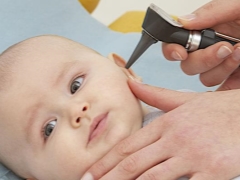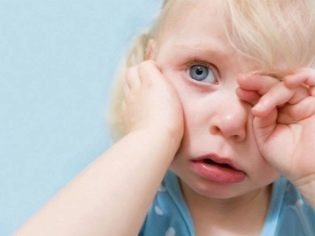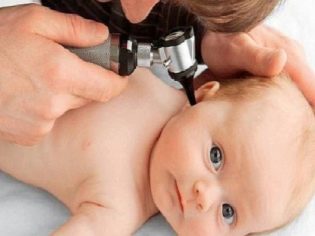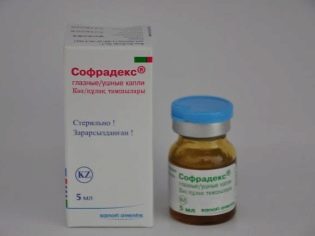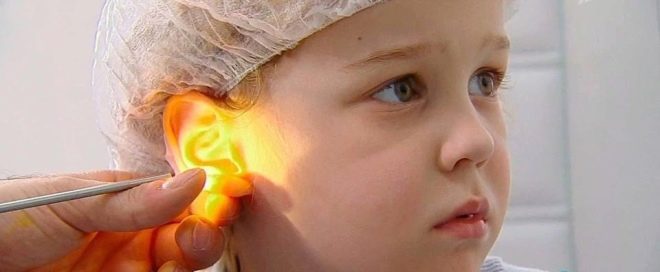Symptoms and treatment of purulent otitis in a child
Purulent otitis occurs in every third toddler of an early age. Usually, this pathology is quite difficult and is accompanied by the appearance of many of the most adverse symptoms. How to cope with this disease, this article will help to understand.
Causes
The inflammatory process that affects the middle ear cavity often leads to the development of purulent otitis.
Cause this form of the disease can a variety of reasons. The most common of these are bacterial infections. Currently, there are a huge number of various bacteria that can lead to the formation of pus in the cavity of the middle ear.
This pathology can be either primary or appear due to complications of other bacterial infections.
A newborn baby has certain features in the development of purulent otitis. They are associated with the presence of a special myxoid tissue in the middle ear cavity. This element is quite sensitive to the development of bacterial inflammation and the appearance of severe edema.
Myxoid tissue disappears only towards the end of the first month of the baby’s life. It can remain for a longer time only in premature and weak children. In such babies, it usually lasts for 6-12 months of their life. This clinical situation leads to persistent preservation of adverse symptoms in an infant for quite a long time.
The development of the disease also lead certain features of the structure of the Eustachian tube in children. This structural element, which is part of the ear, in children is shorter. This feature contributes to a more rapid spread of the inflammatory process to all adjacent organs. The dimensions of the Eustachian tube increase as the child grows.
Given the duration of the onset of adverse symptoms, doctors identify several clinical variants of this disease. The first developed disease is called acute. As a rule, in children, various bacterial and much less viral or fungal infections.
Chronization of the process ensures the transition from acute to chronic. This variant of the disease is very unfavorable. It is accompanied by a succession of periods of complete well-being and exacerbations.
In most cases, the inflammatory process affects only one side. Much less common bilateral purulent otitis.
Children's otolaryngologists also distinguish recurrent forms of the disease. In this case, exacerbations of the disease occur over a rather short period of time.
Frequent deterioration of the child's well-being should alert the parents. As a rule, recurrent purulent otitis media is a manifestation of a pronounced disorder of the immune system.
The infection can get into the cavity of the middle ear in different ways. The most common option is through the Eustachian tube. In this situation, the pathogenic microorganisms enter the ear cavity through the existing anatomical messages with the nose.
Improper hygiene procedures contribute to the penetration of a secondary infection from the external environment through the outer ear. The spread of bacteria through the blood is found in the presence of the primary focus of the disease, which can be located in different internal organs.
Much less common congenital forms of purulent otitis. In this case, the infection occurs in the period of fetal development. Adverse symptoms of the disease in infants are mainly caused by staphylococcal or streptococcal bacterial flora.
Anaerobic microorganisms cause intrauterine infection of the fetus much less frequently.
Congenital purulent otitis in newborn babies is often bilateral.
Symptoms
Manifest purulent otitis media can be different. The severity of the manifestation of clinical signs depends on the initial state of health of the child. Weakened babies carry the disease most seriously.
The health of newborn babies suffering from purulent otitis suffers significantly. Quite often, treatment of sick babies is carried out in a hospital.
The classic manifestation of this disease - the appearance of pain in the ears. In a one-sided process, the pain is manifested only on one side.
The spread of infection to the other half of the face contributes to the appearance of pain there. The intensity of the sensation of pain may be different and depends on whether this form of the disease is acute or chronic.
Acute inflammation is characterized by the appearance of pronounced pain syndrome. Many kids point out that the nature of the pain can be “shooting through.”
Severe inflammatory process leads to a significant increase in body temperature. In most cases, it reaches 38-39.5. A more severe course of the disease is accompanied by an increase in body temperature above 40 degrees.
The inflammatory process in the middle ear leads to pronounced hearing loss. If a child has only one-sided defeat, then he hears a speech and distinguishes voices.
In a two-way process, hearing is significantly impaired. Children attending school or other educational institutions cannot attend classes, as they experience significant difficulties with the ability to recognize sounds.
A sick child looks very bad. Severe inflammatory process leads to the fact that the baby feels very weak, rapid fatigue. Sick kids eat poorly, their appetite decreases significantly or even disappears completely.
Babies begin to refuse breastfeeding and rather poorly applied to the maternal breast.
The exacerbation of purulent chronic otitis usually proceeds somewhat easier. In some babies, the disease can develop even without a significant increase in body temperature.
Toddlers feel the "gurgling" or "transfusion" in the area of the affected ear. This symptom is often aggravated by a change in body position.
Congestion in the affected ear during exacerbation of chronic otitis media usually has an increasing intensity. In some babies, suppuration becomes almost permanent.
The amount of fluid discharged from the eye can vary. The long course of the disease contributes to the development of persistent disturbances in the perception of sounds.
Many children note that in the affected ear they feel severe itchingwhich brings them strong discomfort. Also, the sick child appears hypersensitivity to any tactile touch of the affected area.
Complicating the course of the disease is the appearance of a headache that appears on the side of the damaged ear.
The behavior of the sick child changes significantly. The kid becomes more sluggish, naughty. Quite often, the child loses the usual interest in their favorite toys.
The children begin to rub the affected ear on the pillow more, because they feel a strong itch. The youngest kids often touch the affected ear. This symptom should alert the parents and motivate them to treat the child for consultation with a doctor.
Diagnostics
Carrying out diagnostic measures and treatment of purulent otitis holds children's otolaryngologist. To determine the inflammatory process in the ear cavity, the doctor conducts an extended clinical examination and examination with a special medical instrument. This study is called otoscopy. Using this visual test, you can determine the presence of pus in the cavity of the middle ear.
Laboratory tests are carried out to determine the cause of the disease.
In purulent otitis media, normal blood counts are significantly altered. A huge number of leukocytes appear in it, the leukocyte formula changes, and also the ESR increases.
In some cases, children's otolaryngologists conduct bakposev contents obtained from the cavity of the affected ear. This test is very specific and allows you to accurately identify the infectious pathogen.
A significant disadvantage of this study is the duration of the analysis. It may take 5-7 days to get the results of this lab test.
Effects
Purulent otitis often quite dangerous. The most severe course is observed in toddlers of very early age. The spread of inflammation leads to damage to adjacent organs.
The most dangerous complication of the disease - hitting pus in the meninges. This condition leads to the development meningitis or meningoencephalitis.
A common complication of purulent otitis is hearing loss. In the most severe cases, impaired sound perception can be expressed significantly. This symptom may be manifested by complete hearing loss.
In babies, this can lead to decrease in memory and intelligence. In infants, this pathological condition contributes to a pronounced lag in mental development.
The transition to the anatomical structures of the inner ear is also a fairly frequent complication of purulent otitis. This pathological condition is called labyrinthitis.
Severe course of this pathology can lead to the development of the most dangerous complications, manifested by lesions of the bone tissue of the temporal bone and even facial nerve palsy.
Treatment
Therapy of purulent otitis can be performed using various drugs. The most common method of treatment is prescribing drugs.
To achieve a good effect of the therapy required, the use of a whole range of different means is required. The purpose of taking these drugs is to eliminate all adverse symptoms and improve hearing.
The basic method of treatment is the prescription of antibacterial drugs. These funds are assigned to the exchange rate. 7-10 days are usually sufficient to eliminate all adverse symptoms.
The elimination of pathogens from the cavity of the affected ears is an important strategic task of therapy. To do this, antibiotics are used, having a wide range of actions.
Antibacterial agents can be administered in different ways. In case of moderate course of the disease, drugs in the form of tablets or suspensions are used.
Severe forms of illness require prescription already antibiotics in the form of injections. The most commonly prescribed drugs include: «Amoxicillin"," Augmentin "," Flemoxin "," Cefuroxime " other. Frequency, course dosages and duration of treatment are determined by the attending physician.
Purulent otitis often occurs after a prolonged rhinitis. To normalize nasal breathing in this situation, vasoconstrictor nasal drops or sprays are prescribed. They are appointed for 4-5 days up to 2-3 times a day. These funds also improve the pressure in the Eustachian tube, which leads to a decrease in edema. These drugs include: "Sanorin», «Galazolin"," Nazol "," Otrivin "and others.
Various antipyretic drugs are used to normalize high body temperature.In children's practice, the most frequently used drugs are based on paracetamol or ibuprofen.
These drugs have a lower risk of unwanted side effects. Use these drugs should be when the body temperature rises above 38 degrees.
Quite often, various ear drops are used to treat purulent forms of otitis at home. They help to eliminate the pain syndrome that has arisen in the affected ear, and also have a pronounced antiseptic effect.
Quite often, various ear drops are used to treat purulent forms of otitis at home. They help to eliminate the pain syndrome that has arisen in the affected ear, and also have a pronounced antiseptic effect.
Course use of these drugs also has a strong anti-inflammatory effect. As such drugs in children's practice are used: «Otipaks"," Sofradex ","Otofa».
Purulent forms of the disease are quite common in babies with signs of immunodeficiency. To restore optimal performance of the immune system, doctors prescribe specific medications for sick babies.
"Viferon" and multivitamin complexes with course application will allow to achieve a lasting positive effect.
Fathers and mothers should remember that the use of all drugs must necessarily be coordinated with your doctor.
Many of the remedies used for treatment cannot be used if there is a perforation (pathological hole) in the eardrum. Such a clinical condition can quite often occur with purulent otitis. The most dangerous in this case, ear drops, which are applied topically.
In some cases, conducting conservative drug therapy does not lead to the achievement of the effect. In this situation, surgical treatment may be required. Such operations can reduce the excess pressure inside the ear cavity, as well as eliminate the pronounced inflammation. Conduct such a surgical treatment children's otolaryngologists.
In some cases, conducting conservative drug therapy does not lead to the achievement of the effect. In this situation, surgical treatment may be required. Such operations can reduce the excess pressure inside the ear cavity, as well as eliminate the pronounced inflammation. Carry out such surgical treatment of children's otolaryngologists.
The removal of pus from the ear cavity is called a puncture. He is conducted by a doctor using a special tool. Local anesthesia is used for anesthesia.
After the entire procedure is completed, a gauze turunda soaked in a disinfectant solution is injected into the affected ear. After the operation, the doctors recommend that the child not drench the ear for several days and prescribe a number of drugs that help to finally cope with the inflammation.
Physiotherapy plays an important role in the treatment of chronic purulent otitis. The methods of such therapy allow to eliminate the pronounced inflammation in the area of the affected ear, and also have a positive effect on the immune system.
Physiotherapeutic methods of treatment are used already in the period of subsiding of the acute period of the disease, when the purulent discharge from the ear no longer exists. Laser therapy, UHF - therapy and pneumomassage of the eardrum - The most common methods that are used in the treatment of purulent otitis in children of different ages.
You can learn more about how to treat otitis media from Dr. Komarovsky in the next video.
